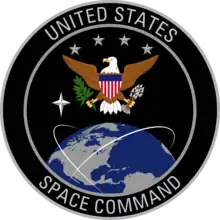Air Force Space Command
Air Force Space Command (AFSPC) was the major space command of the United States Air Force and the de facto space force of the United States Armed Forces from 1982 to 2016. Air Force Space Command was created on 1 September 1982 to unify the Air Force's space forces, which were organized under Air Force Systems Command, Aerospace Defense Command, and Strategic Air Command and is the direct predecessor to the United States Space Force, one of the six military services in the United States Armed Forces. Air Force Space Command was the first military space command in the U.S. Air Force, providing space forces for the 1983 United States invasion of Grenada, 1986 United States bombing of Libya, and 1989 United States invasion of Panama. The first major employment of space forces culminated in the Gulf War, where they proved so critical to the U.S.-led coalition, that it is sometimes referred to as the first space war. [4]
| Air Force Space Command | |
|---|---|
 Shield of Air Force Space Command | |
| Active | 1 September 1982 – 20 December 2019 (37 years, 3 months) Detailed
|
| Country | |
| Branch | |
| Type | Space force Air Force major command |
| Role | Space warfare[2] |
| Part of | |
| Headquarters | Peterson Air Force Base, Colorado, U.S. |
| Motto(s) | "Guardians of the High Frontier"[3] |
| Decorations | Air Force Organization Excellence Award[1] |
| Website | www |
| Commanders | |
| Notable commanders | Lt Gen Thomas S. Moorman Jr. (1990–1992) Gen Kevin P. Chilton (2006–2007) Gen John E. Hyten (2014–2016) Gen John W. Raymond (2016–2019) |
History
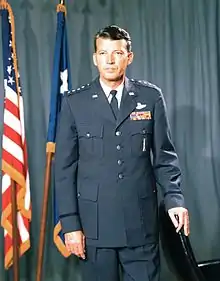
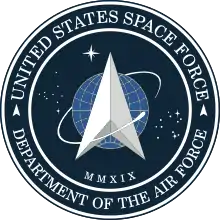
Following the conclusion of the Second World War in 1945. Early military space development was begun within the United States Army Air Forces by General Henry H. Arnold, who identified space as a crucial military arena decades before the first spaceflight. Gaining its independence from the Army on 18 September 1947, the United States Air Force began development of military space and ballistic missile programs, while also competing with the United States Army and United States Navy for the space mission.[5]
In 1954, the Air Force created its first space organization, the Western Development Division, under the leadership of General Bernard Schriever. The Western Development Division and its successor organization, the Air Force Ballistic Missile Division, were instrumental in developing the first United States military launch vehicles and spacecraft, competing predominantly with the Army Ballistic Missile Agency under the leadership of General John Bruce Medaris and former German scientist Wernher von Braun. The launch of Sputnik 1 spurred a massive reorganization of military space and the 1958 establishment of the Advanced Research Projects Agency was a short-lived effort to centralized management of military space, with some fearing it would become a military service for space, with authorities being returned to the services in 1959. The establishment of NASA in 1958, however, completely decimated the Army Ballistic Missile Agency, resulting in the Air Force Ballistic Missile Division serving as the primary military space organization. In 1961, the Air Force was designated as the Department of Defense's executive agent for space and Air Research and Development Command was reorganized into Air Force Systems Command, with the Air Force Ballistic Missile Division being replaced by the Space Systems Division - the first Air Force division solely focused on space. In the 1960s, military space activities began to be operationalized, with Aerospace Defense Command taking control of missile warning and space surveillance on behalf of NORAD, Strategic Air Command assuming the weather reconnaissance mission, and Air Force Systems Command operating the first generations of communications satellites on behalf of the Defense Communications Agency. In 1967, the Space Systems Division and Ballistic Missiles Division were merged to form the Space and Missile Systems Organization, which began to develop the next generation of satellite communications, space-based missile warning, space launch vehicles and infrastructure, and the predecessor to the Global Positioning System. Space forces also saw their first employment in the Vietnam War, providing weather and communications support to ground and air forces.[6]
— John F. Kennedy, speech at Rice University, 12 September 1962[7]
The disjointed nature of military space forces across three military commands resulted in a reevaluation of space force organization within the Air Force. In 1979, the Space and Missile Systems Organization was split, forming the Space Division, and in 1980, Aerospace Defense Command was inactivated and its space forces transferred to Strategic Air Command. Resulting from internal and external pressures, including an effort by a congressman to rename the Air Force into the Aerospace Force and the possibility that President Reagan would direct the creation of a space force as a separate military branch, the Air Force directed the formation of Air Force Space Command in 1982. During the 1980s, Air Force Space Command absorbed the space missions of Strategic Air Command and the launch mission from Air Force Systems Command. Space forces provided space support during the Falklands War, United States invasion of Grenada, the 1986 United States bombing of Libya, Operation Earnest Will, and the United States invasion of Panama. The tactical employment of space forces culminated in the Gulf War, where space forces proved so critical to the U.S.-led coalition, that it is sometimes referred to as the first space war.[8]
Following the end of the Gulf War, the Air Force came under intense congressional scrutiny by seeking to artificially merge its air and space operations into a seamless aerospace continuum, without regard for the differences between space and air. The 2001 Space Commission criticized the Air Force for institutionalizing the primacy of aviation pilots over space officers in Air Force Space Command, for stifling the development of an independent space culture, and not paying sufficient budgetary attention to space. The Space Commission recommended the formation of a Space Corps within the Air Force between 2007 and 2011, with an independent Space Force to be created at a later date. Following the recommendation of the Space Commission, the Space and Missile Systems Center was transferred from Air Force Materiel Command to Air Force Space Command. The September 11 attacks derailed most progress in space development, resulting in the inactivation of United States Space Command and beginning a period of atrophy in military space. The only major change to occur was the transfer of the Space and Missile Systems Center from Air Force Materiel Command to Air Force Space Command. Following the inactivation of U.S. Space Command in 2002, Russia and China began developing developing sophisticated on-orbit capabilities and an array of counter-space weapons, with the 2007 Chinese anti-satellite missile test of particular concern as it created 2,841 high-velocity debris items, a larger amount of dangerous space junk than any other space event in history. On 29 August 2019, United States Space Command was reestablished as a geographic combatant command.[9]
The first major employment of space forces culminated in the Gulf War, where they proved so critical to the U.S.-led coalition, that it is sometimes referred to as the first space war. The first discussions of creating a military space service occurred in 1958, with the idea being considered by President Reagan as well in 1982. The 2001 Space Commission argued for the creation of a Space Corps between 2007 and 2011 and a bipartisan proposal in the U.S. congress would have created a Space Corps in 2017. On 20 December 2019, the United States Space Force Act, part of the National Defense Authorization Act for 2020, was signed, creating an independent space service by renaming and reorganizing Air Force Space Command into the United States Space Force.[10]
Legacy
Following the establishment of the U.S. Space Force in 2019, it based many of its cultural decisions on its legacy as Air Force Space Command. Space Force members are referred to as "guardians" in honor of Air Force Space Command's motto "guardians of the high frontier"[11] and the design of the Space Force Delta, seal, and flag all paid homage to the original Air Force Space Command shield and space operations badge.[12]
Resources
Satellites
Space situational awareness
Ballistic missile warning radars
- AN/FPS-115 PAVE PAWS
- AN/FPS-108 Cobra Dane
- AN/FPQ-16 Perimeter Acquisition Radar Characterization System (PARCS)
- Sea-based X-band Radar
- Ballistic Missile Early Warning System (BMEWS)
Organization
Fourteenth Air Force
The Fourteenth Air Force (14 AF) was an active Numbered Air Force that was located at Vandenberg AFB, California. It was responsible for launching payloads to space from facilities in California and Florida and managed the generation and employment of space forces to support U.S. Strategic Command and North American Aerospace Defense Command (NORAD) operational plans and missions.[13]
Direct Reporting Units
AFSPC was responsible for providing space assets to the U.S. Strategic Command. AFSPC also supported NORAD with ballistic missile warning information, operates the Space Warfare Center to develop space capabilities, and was responsible for the US DoD ICBM follow-on operational test and evaluation program.
The Space and Missile Systems Center (SMC) at Los Angeles AFB, California, designs and acquires all Air Force and most Department of Defense space systems. It oversees launches, completes on-orbit checkouts, then turns systems over to user agencies. It supports the program executive officer for Space on the NAVSTAR Global Positioning, Defense Satellite Communications and MILSTAR systems. SMC also supports the Defense Meteorological Satellite Program and the Follow-on Early Warning System. In addition, it supports development and acquisition of land-based intercontinental ballistic missiles for the Air Force Program Executive Office for Strategic Systems.
Locations
The AFSPC headquarters was a major unit located at Peterson AFB, Colorado. There were six AFSPC host bases:
- Buckley AFB, Colorado
- 460th Space Wing
- 233rd Space Group (Colorado Air National Guard)
- Los Angeles AFB, California
- Space and Missile Systems Center
- Global Positioning Systems Directorate
- Space Superiority Systems Directorate
- Launch Systems Directorate
- Infrared Space Systems Directorate
- Defense Weather Systems Directorate
- Military Satellite Communications Systems Directorate
- Space Logistics Directorate
- Missile Defense Systems Directorate
- Space Development and Test Directorate (Kirtland AFB, New Mexico)
- Spacelift Range and Network Systems Division
- 61st Air Base Group
- 61st Civil Engineering and Logistics Squadron
- 61st Medical Squadron
- 61st Mission Support Squadron
- Space and Missile Systems Center
- Patrick AFB and Cape Canaveral AFS, Florida
- Peterson AFB, Colorado
- 21st Space Wing
- 821st Air Base Group (GSU at Thule Air Base, Greenland)
- 20th Space Control Squadron (GSU at Eglin AFB Site C-6, Florida
- 310th Space Wing (AFRC)
- 21st Space Wing
- Schriever AFB, Colorado
- Vandenberg AFB, California
AFSPC also operated several Air Force Stations for launch support and early warning missions:
- Cape Cod Air Force Station, Massachusetts
- Cavalier AFS, North Dakota
- Cheyenne Mountain AFS, Colorado
- Clear Air Force Station, Alaska
- Greeley Air National Guard Station, Colorado
- New Boston AFS, New Hampshire
List of commanders
| No. | Commander[14][15] | Term | |||
|---|---|---|---|---|---|
| Portrait | Name | Took office | Left office | Duration | |
| 1 | General James V. Hartinger (1925–2000) | 1 September 1982 | 20 July 1984 | 1 year, 323 days | |
| 2 | General Robert T. Herres (1932–2008) | 20 July 1984 | 1 October 1986 | 2 years, 73 days | |
| 3 | Major General Maurice C. Padden | 1 October 1986 | 29 October 1987 | 1 year, 28 days | |
| 4 | Lieutenant General Donald J. Kutyna (born 1933) | 29 October 1987 | 29 March 1990 | 2 years, 151 days | |
| 5 | Lieutenant General Thomas S. Moorman Jr. (1940–2020) | 29 March 1990 | 23 March 1992 | 1 year, 360 days | |
| 6 | General Donald J. Kutyna (born 1933) | 23 March 1992 | 30 June 1992 | 99 days | |
| 7 | General Chuck Horner (born 1936) | 30 June 1992 | 13 September 1994 | 2 years, 106 days | |
| 8 | General Joseph W. Ashy (born 1940) | 13 September 1994 | 26 August 1996 | 1 year, 348 days | |
| 9 | General Howell M. Estes III (born 1941) | 26 August 1996 | 14 August 1998 | 1 year, 353 days | |
| 10 | General Richard Myers (born 1942) | 14 August 1998 | 22 February 2000 | 1 year, 192 days | |
| 11 | General Ralph Eberhart (born 1946) | 22 February 2000 | 19 April 2002 | 2 years, 56 days | |
| 12 | General Lance W. Lord (born 1946) | 19 April 2002 | 1 April 2006 | 3 years, 347 days | |
| – | Lieutenant General Frank Klotz (born 1950) Acting | 1 April 2006 | 26 June 2006 | 86 days | |
| 13 | General Kevin P. Chilton (born 1954) | 26 June 2006 | 3 October 2007 | 1 year, 99 days | |
| – | Lieutenant General Michael A. Hamel Acting | 3 October 2007 | 12 October 2007 | 9 days | |
| 14 | General C. Robert Kehler (born 1952) | 12 October 2007 | 5 January 2011 | 3 years, 85 days | |
| 15 | General William L. Shelton (born 1954) | 5 January 2011 | 15 August 2014 | 3 years, 222 days | |
| 16 | General John E. Hyten (born 1959) | 15 August 2014 | 25 October 2016 | 2 years, 71 days | |
| 17 | General John W. Raymond (born 1962) | 25 October 2016 | 20 December 2019 | 3 years, 56 days | |
See also
References
- "Air Force Space Command (USAF)". Air Force Historical Research Agency.
- "Air Force Space Command > About Us". www.afspc.af.mil.
- "Air Force Space Command Heritage". Air Force Space Command. Archived from the original on 22 March 2014. Retrieved 21 March 2014.
- Browne, Ryan (21 December 2019). "With a signature, Trump brings Space Force into being". CNN. CNN. Retrieved 21 December 2019.
When President Donald Trump signed the National Defense Authorization Act into law Friday, he also created the newest military service and the first new service since the US Air Force came into being in 1947. With his signature, the US Air Force Space Command was designated the United States Space Force, a step that White House officials are touting as a historic step. "The law states that Air Force Space Command will be re-designated the United States Space Force, that will happen immediately," Gen. John Raymond, the commander of US Space Command and Air Force Space Command, told reporters at the Pentagon Friday.
- https://media.defense.gov/2011/Jan/25/2001330110/-1/-1/0/AFD-110125-038.pdf
- https://media.defense.gov/2011/Jan/25/2001330110/-1/-1/0/AFD-110125-038.pdf
- JFK Library, Address at Rice University, September 12, 1962 (USG 15 29) on YouTube, Houston, Texas, concerning the nation's efforts in space exploration, minutes 7:16–8:00.
- https://media.defense.gov/2011/Jan/25/2001330110/-1/-1/0/AFD-110125-038.pdf
- https://media.defense.gov/2011/Jan/25/2001330110/-1/-1/0/AFD-110125-038.pdf
- https://media.defense.gov/2011/Jan/25/2001330110/-1/-1/0/AFD-110125-038.pdf
- Morales, Christina (19 December 2020). "The Newest Guardians of the Galaxy Are Run by the U.S. Military". The New York Times. ISSN 0362-4331. Retrieved 30 December 2020.
- "U.S. Space Force says its new seal is not a Starfleet knockoff". SpaceNews.com. Retrieved 4 April 2020.
- "14th Air Force (Air Forces Strategic)". Vandenberg Air Force Base website. United States Air Force. Archived from the original on 21 April 2013. Retrieved 3 April 2013.
- http://www.space-library.com/0908AFM_SpaceAlmanac.pdf
- https://www.afhra.af.mil/About-Us/Fact-Sheets/Display/Article/433549/air-force-space-command-usaf/
![]() This article incorporates public domain material from the Air Force Historical Research Agency website http://www.afhra.af.mil/.
This article incorporates public domain material from the Air Force Historical Research Agency website http://www.afhra.af.mil/.
External links
- "Air Force Space Command Fact Sheet". Air Force Space Command. August 2015. Archived from the original on 3 March 2016.
- "Air Force Space Command Fact Sheet". Air Force. April 2003. Archived from the original on 24 June 2003.

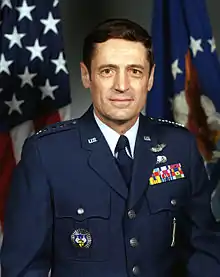
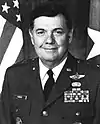
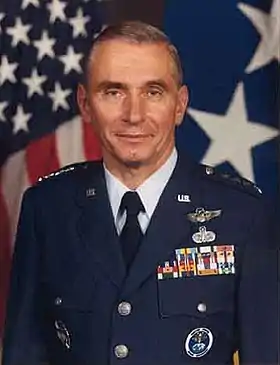
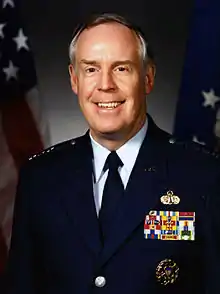
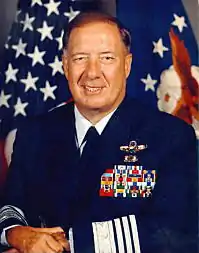
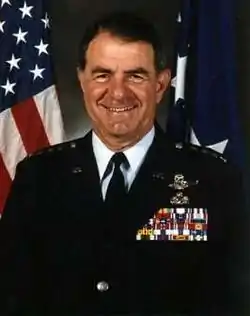
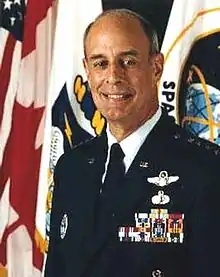
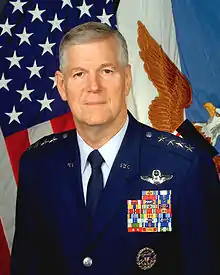
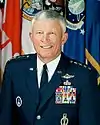



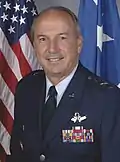
.jpg.webp)

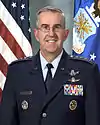
.jpg.webp)

